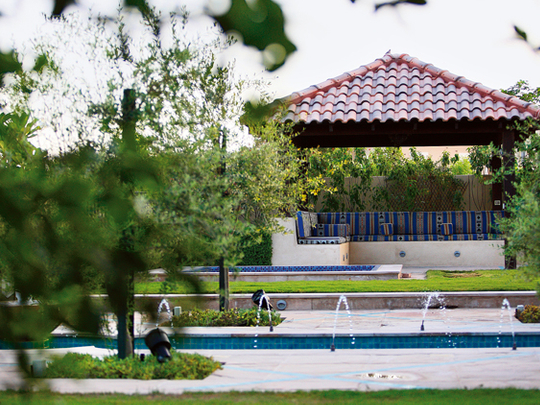
1. Design and style
Start with a simple and practical approach in a style that suits the location and your preferences. Edwina Stuart, landscape consultant, Desert Group, says, "Consider site conditions such as sunlight and shade when planning. Creating buffers with large, hardy barrier plants to protect the smaller species or planting types that thrive in harsh conditions in the region could be helpful."
2. Choosing plants
With limited native species available here, it is worth considering plants that are low cost and low maintenance. Plants such as leucophyllum frutescens (hedge plants) and sesuvium (ground covering succulents) are good choices to start. Succulents need less water during winter, while during summer months their water intake increases. Less hardy plants will need daily watering.
3. Toil the soil
It is important for your plants to receive the right amount of nutrients to look fresh and healthy. Adding organic fertiliser helps but Edwina warns not to overfeed your plants. "The amount varies based on the kind of plants you have in your garden, as different species have different nutritional requirements." Ask at your local garden centre if you are unsure.
4. Mulch, mulch, mulch
The extreme heat can make it difficult for plants to grow. Applying mulch, which acts as a protective cover over the soil to retain moisture, can work wonders. Edwina says, "Mulch helps to keep the soil moist, prevent weeds and slowly releases food for the plants." Plus it looks nicer than sand.
5. Water wisely
A water-efficient garden can help save money on your utility bills. Remember pots dry out faster and will need regular monitoring. Edwina advises installing an irrigation system to ensure consistency. For large plots, an automated system is helpful. Plants such as agaves, sansevieria, yuccas and adenium obesum (desert rose) are options that don't need much water.
6. Go natural
Making your own compost is not only good for your plants, but it's a cheap and eco-friendly way to dispose of your organic waste. "Use organic fertilisers or homemade compost from food waste [to nourish your garden]," Edwina says. Coffee grounds are an excellent fertiliser, while egg shells, tea bags and raw vegetable peelings are great to throw in the bin. Avoid composting cooked foods as they will attract pests.
7. Seek professional advice
A garden is prone to weeds and pests. You can expect anything from bugs and soldier worms on your lawn to red weevils in your date palms. A range of pesticides and herbicides are available to combat these nuisances but Edwina says each infestation requires a different treatment so it's best to consult an expert.
8. From green to grey
Lawns are high maintenance so introducing hardscapes like walkways and patios could help keep your costs down. Remember that hardscapes should be designed to complement the rest of your garden. Edwina recommends versatile options such as artificial turf, concrete or stones. "Composite decking, though more expensive to install, is a maintenance-free alternative," she says.
9. Get the look just right
Furniture, lighting and design accessories are great ways to enhance your garden. Using solar or LED lights makes the space more alluring and ambient. For furniture, the options are endless. Incorporating entertaining elements such as a built-in barbecue, kitchen and serving area can help create a relaxing space to enjoy your time outside. Water features are affordable, easy to maintain and add a relaxing touch to gardens.
10. Must-have kit
Some must-have gardening tools that Edwina recommends are a hose, a small trowel, a high-quality pair of gardening gloves, shears for light pruning and a bin or garden unit to store fertilisers and other chemicals safely.











